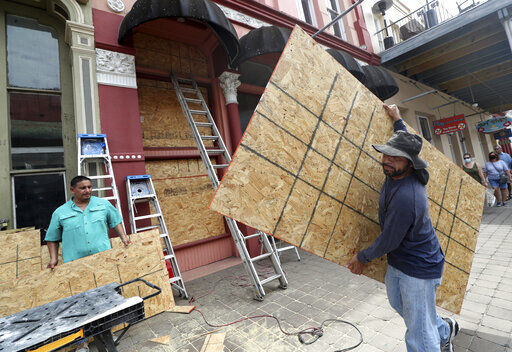NEW ORLEANS — Tropical Storm Laura entered the warm and deep waters of the Gulf of Mexico today, gathering strength on a path to hit the U.S. coastline early Thursday as a major hurricane that could unleash a surge of seawater higher than a basketball hoop and swamp entire towns.
The National Hurricane Center projected this morning that Laura will become a Category 3 hurricane before landfall, with winds of around 115 mph, capable of devastating damage.
“This storm is going to be intensifying all the way up until landfall … We want you to prepare as if it’s going to be a Category 3,” said Donald Jones, a meteorologist at the National Weather Service office in Lake Charles, La. — in the bullseye of Laura’s projected path.
University of Miami hurricane researcher Brian McNoldy also said that he would “give it a pretty decent chance of a Category 3 or 4, not necessarily at landfall, at least during its lifetime in the Gulf.”
Still a tropical storm for now, Laura passed Cuba after killing at least 11 people in the Dominican Republic and Haiti, where it knocked out power and caused flooding in the two nations that share the island of Hispaniola. The deaths reportedly included a 10-year-old girl whose home was hit by a tree and a mother and young son who were crushed by a collapsing wall.
Now forecasters are turning their attention the Gulf Coast, where up to 11 feet of sea water — storm surge — could inundate the coastline from High Island in Texas to Morgan City, La., the hurricane center said. On top of that, up to 15 inches of rain could fall in some spots in Louisiana, Jones said.
“Whatever happens, happens. We’re going to roll with the punches,” said Capt. Brad Boudreaux, who operates a fishing guide service in Hackberry, La., near the Texas line.
The silver lining for U.S. coastal residents is that an earlier storm — Marco — greatly weakened and became a remnant just off Louisiana’s shore today. Satellite images showed a disorganized cluster of clouds. It was relegated to what meteorologists call “a naked swirl,” Jones said.
Laura was sustaining top winds of 65 mph this morning after passing between the western tip of Cuba and Mexico’s Yucatan Peninsula. It was centered 680 miles southeast of Lake Charles, and moving toward the U.S. coast at 17 mph.
The hurricane center warned people not to focus on the details of the official forecast, since “storm surge, wind, and rainfall hazards will extend well away from Laura’s center along the Gulf Coast.”
In Port Arthur Texas, Mayor Thurman Bartie issued a mandatory evacuation order for the city’s more than 54,000 residents starting at 6 a.m. today. People planning on entering official shelters can bring just one bag of personal belongings each, and must “have a mask” to reduce the spread of coronavirus, the order said.
“If you decide to stay, you’re staying on your own,” Bartie said.
Officials in Houston asked residents to prepare supplies in case they lose power for a few days or need to evacuate homes along the coast.
State emergencies were declared in Louisiana and Mississippi, and shelters opened with cots set farther apart, among other measures designed to curb infections.
Laura’s unwelcome arrival comes just days before the Aug. 29 anniversary of Hurricane Katrina, which breached the levees in New Orleans, flattened much of the Mississippi coast and killed as many as 1,800 people in 2005. Hurricane Rita then struck southwest Louisiana that Sept. 24 as a Category 3 storm.
Now southwest Louisiana again faces the threat of being hit by a major hurricane, and Rita is on the mind of Ron Leleux.
“Finally we ran out of luck in 2005 with Rita,” Leleux said from his home in Sulphur, where he served as mayor from 2002-2010. “When something like this comes up, I think people go back and it brings back a lot of bad memories.”
In the southwest corner of Louisiana, Capt. Tommy Adams, a local fishing guide, was prepared for anything but said “you never know what’s going to happen.
“I’m moving to a house a little more inland just to be on the safe side, probably about an hour north, just to be on the safe side,” said Adams, who also lives in Sulphur.
In Waveland, Miss., a coastal town devastated by Hurricane Katrina in 2015, Jeremy Burke said “our biggest threat down here is the storm surge.” When Katrina struck, “the wind did do damage, but the thing that put the nail in the coffin was the storm surge,” said Burke, who owns Bay Books in nearby Bay St. Louis.
Many residents in Waveland are staying in place as Laura bears down on the coast, but they also have their cars and trucks gassed up in case the forecast grows more ominous, Burke said.
“People are prepared to possibly go at the drop of a hat,” he said. “We never take a storm for granted. We might have dodged a bullet with Marco, and obviously some people along the Gulf Coast are not going to be as blessed as us.”


